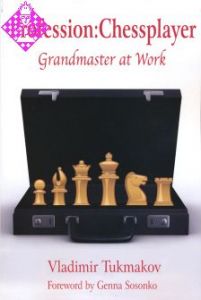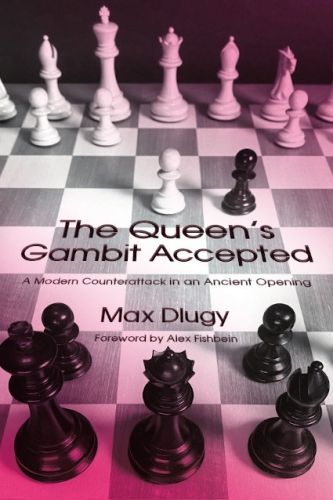Article Number
LODLUTQGA
Author
The Queen's Gambit Accepted - 2nd ed.
392 pages, paperback, Russell Enterprises, 2. edition 2024
Forging New Paths in an Ancient Opening
The Queen’s Gambit Accepted is one of the oldest known openings in chess. It was first mentioned in chess literature in the late 15th century. Over 500 years later, American Grandmaster Max Dlugy demonstrates in this groundbreaking work that the QGA is still a fighting, uncompromising opening that allows Black to play for a win from the very first move.
But his comprehensive coverage is something players who face the QGA with White will also want to study. Dlugy not only carefully maps out Black’s best strategy, but also gives ample consideration to how White should play. The positions analyzed are a blend of the tactical elements and the key positional considerations such as space, time and pawn structure to be assessed when choosing your lines.
This book will teach you not just the QGA, but chess strategy in general. It will teach you how to play solid yet lively positions and allow you to take something away from Maxim Dlugy’s classical style and lucid explanations. If you want to improve your chess while learning a reliable opening with Black, you are now reading the book you need. From the Foreword by GM Alex Fishbein
Max Dlugy has great experience with the QGA, having played it successfully for over 40 years. In this book, he presents new analysis in established lines and rehabilitates many variations, turning existing theory on its head. Whether you play White or Black, this creative, cutting-edge treatment of the Queen’s Gambit Accepted will be indispensable.
This revised, expanded second edition has an additional 40 pages of new material and analysis.
About the Author
American Grandmaster Max Dlugy moved to New York from Moscow when he was just 11 years old. His first chess rating when he was 12 was 1406. However, Max had excellent coaches early on Jack Collins and Vitaly Zaltsman. This, coupled with his love and determination for improvement, led to his becoming the highest rated player in his age group by the time he was 15.
At 16 he became an international master, and at 19, World Junior Champion and a Grandmaster, entering the top 50 players in the world. By the time Max was 24 still at the top of his game he was among the elite in the U.S., rated in the top five players. At that time, the financial world beckoned and he put his chess career on hold.
In 1990, he became president of the United States Chess Federation and a board member of the Grandmaster’s Association.
In 2014, Max turned to chess organization and teaching. He founded one of the most successful chess schools in the country, Chess Max Academy. With locations in New York and Connecticut, Chess Max Academy teaches children in person as well as online. His students have won dozens of National Scholastic titles, FIDE titles and major competitions.
Max has extensive experience with the Queen’s Gambit Accepted. It has been a very successful workhorse for him and has been part of his repertoire for over forty years. This is his first book for Russell Enterprises.
The Queen’s Gambit Accepted is one of the oldest known openings in chess. It was first mentioned in chess literature in the late 15th century. Over 500 years later, American Grandmaster Max Dlugy demonstrates in this groundbreaking work that the QGA is still a fighting, uncompromising opening that allows Black to play for a win from the very first move.
But his comprehensive coverage is something players who face the QGA with White will also want to study. Dlugy not only carefully maps out Black’s best strategy, but also gives ample consideration to how White should play. The positions analyzed are a blend of the tactical elements and the key positional considerations such as space, time and pawn structure to be assessed when choosing your lines.
This book will teach you not just the QGA, but chess strategy in general. It will teach you how to play solid yet lively positions and allow you to take something away from Maxim Dlugy’s classical style and lucid explanations. If you want to improve your chess while learning a reliable opening with Black, you are now reading the book you need. From the Foreword by GM Alex Fishbein
Max Dlugy has great experience with the QGA, having played it successfully for over 40 years. In this book, he presents new analysis in established lines and rehabilitates many variations, turning existing theory on its head. Whether you play White or Black, this creative, cutting-edge treatment of the Queen’s Gambit Accepted will be indispensable.
This revised, expanded second edition has an additional 40 pages of new material and analysis.
About the Author
American Grandmaster Max Dlugy moved to New York from Moscow when he was just 11 years old. His first chess rating when he was 12 was 1406. However, Max had excellent coaches early on Jack Collins and Vitaly Zaltsman. This, coupled with his love and determination for improvement, led to his becoming the highest rated player in his age group by the time he was 15.
At 16 he became an international master, and at 19, World Junior Champion and a Grandmaster, entering the top 50 players in the world. By the time Max was 24 still at the top of his game he was among the elite in the U.S., rated in the top five players. At that time, the financial world beckoned and he put his chess career on hold.
In 1990, he became president of the United States Chess Federation and a board member of the Grandmaster’s Association.
In 2014, Max turned to chess organization and teaching. He founded one of the most successful chess schools in the country, Chess Max Academy. With locations in New York and Connecticut, Chess Max Academy teaches children in person as well as online. His students have won dozens of National Scholastic titles, FIDE titles and major competitions.
Max has extensive experience with the Queen’s Gambit Accepted. It has been a very successful workhorse for him and has been part of his repertoire for over forty years. This is his first book for Russell Enterprises.
| EAN | 9781949859959 |
|---|---|
| Weight | 520 g |
| Manufacturer | Russell Enterprises |
| Width | 15 cm |
| Height | 22.8 cm |
| Medium | Book |
| Year of Publication | 2024 |
| Author | Max Dlugy |
| Language | English |
| Edition | 2 |
| ISBN-13 | 978-1-949859-95-9 |
| Pages | 392 |
| Binding | paperback |
| Name | Russell Enterprises |
|---|---|
| Adresse | 234 Depot Road Milford, CT 06460 USA |
| Internet | www.Russell-Enterprises.com |
| hwr@russell-enterprises.com |
Verantwortlicher Importeuer:
| Name | Schachversand Niggemann |
|---|---|
| Adresse | Schadowstraße 5 48163 Münster Deutschland |
| info@schachversand.de | |
| Internet | www.schachversand.de |
Max Dlugy’s Magnum Opus.
In this really rather formidable opening monograph, clocking in at just short of 400 pages, Max Dlugy provides black with an in-depth repertoire against the Queen’s Gambit, following the moves 1.d4 d5 2.c4 dxc4 or 2.Nf3 Nf6 3.c4 dxc4. It should be noted that the book does not offer a repertoire against 1.d4 in all its guises, since queen’s pawn games like the London, the Trompowsky and the Veresov (to give just three examples) are absent. But books covering those specific systems are, of course, readily available.
Against the Central Variation (1.d4 d5 2.c4 dxc4 3.e4) Dlugy supplies black with two options: 3…b5, a line pioneered by Vitaly Zaltsman, who was once incidentally Dlugy’s coach, and 3…e5 4.Nf3 Bb4+, when white does best to play 5.Nc3. Both lines are viable, but can become fiendishly complicated; and to obtain equality black sometimes has to play very accurately indeed. Still, it is heartening to see that the Zaltsman Variation is in such rude health. Its vitality is undiminished with time.
The other chief line for white is 3.Nf3 a6 (Dlugy’s preferred move order) 4.e3 (needless to say, alternatives are fully addressed as well) when black should play 4…e6 or 4…Nf6, both moves usually leading to the same outcome, rather than 4…b5, a move which Dlugy distrusts and indeed casts doubt upon. I would characterise The Queen’s Gambit Accepted as a monograph, rather than as simply a repertoire book, because Dlugy devotes a quite detailed chapter to 4…b5, even though it is not a recommendation. His analysis here, in Chapter 5, also strikes me as theoretically significant.
Other lines tackled in the book include 3.e3 e5 (black is doing fine here) and 1.d4 d5 2.Nf3 Nf6 3.c4 dxc4 4.Nc3 a6, where Dlugy retains the spirit of previous lines even though the delayed c4 means that black has played …Nf6 prior to …a6 in this particular case.
There is a ‘Quickstarter!’ section prior to the detailed theoretical survey, serving to give you the gist of the proposed repertoire by summarising the crucial lines and ideas. Afterward there are 72 annotated games and a further 30 supplemental games (the latter appear without notes), which set out the character of the struggle following the opening. Dlugy provides takeaway lessons in the conclusion to each game; and these comments are mightily instructive in and of themselves. Be in no doubt, he is in the business of imparting chess wisdom through the medium of the Queen’s Gambit Accepted: this is not just an opening book.
All in all, I was very much impressed with The Queen’s Gambit Accepted. Dlugy’s recommended lines are ambitious and sharp when needs be, there is plenty of original analysis throughout, and innovations are suggested for white as well as black. It is evident that Max Dlugy is an honest broker: Yes, he is an advocate for black’s cause, but he is not unduly biased in favour of it. What is evident also, on each and every page, is his fine chess intelligence.
My review would, however, be incomplete if I failed to issue a word of warning to the prospective reader: get this book only if you are serious about playing the Queen’s Gambit Accepted as your main defence to 1.d4. For Dlugy has put an immense amount of work into it, and you will need to put in an equivalent amount of effort to get the most out of it. If you are already sold on the Queen’s Gambit Accepted though, and play it regularly as black, the decision is a straightforward no-brainer: this is a book you need to acquire asap.
Paul Kane
https://thecaissakid.wordpress.com/2025/03/21/the-queens-gambit-accepted/
In this really rather formidable opening monograph, clocking in at just short of 400 pages, Max Dlugy provides black with an in-depth repertoire against the Queen’s Gambit, following the moves 1.d4 d5 2.c4 dxc4 or 2.Nf3 Nf6 3.c4 dxc4. It should be noted that the book does not offer a repertoire against 1.d4 in all its guises, since queen’s pawn games like the London, the Trompowsky and the Veresov (to give just three examples) are absent. But books covering those specific systems are, of course, readily available.
Against the Central Variation (1.d4 d5 2.c4 dxc4 3.e4) Dlugy supplies black with two options: 3…b5, a line pioneered by Vitaly Zaltsman, who was once incidentally Dlugy’s coach, and 3…e5 4.Nf3 Bb4+, when white does best to play 5.Nc3. Both lines are viable, but can become fiendishly complicated; and to obtain equality black sometimes has to play very accurately indeed. Still, it is heartening to see that the Zaltsman Variation is in such rude health. Its vitality is undiminished with time.
The other chief line for white is 3.Nf3 a6 (Dlugy’s preferred move order) 4.e3 (needless to say, alternatives are fully addressed as well) when black should play 4…e6 or 4…Nf6, both moves usually leading to the same outcome, rather than 4…b5, a move which Dlugy distrusts and indeed casts doubt upon. I would characterise The Queen’s Gambit Accepted as a monograph, rather than as simply a repertoire book, because Dlugy devotes a quite detailed chapter to 4…b5, even though it is not a recommendation. His analysis here, in Chapter 5, also strikes me as theoretically significant.
Other lines tackled in the book include 3.e3 e5 (black is doing fine here) and 1.d4 d5 2.Nf3 Nf6 3.c4 dxc4 4.Nc3 a6, where Dlugy retains the spirit of previous lines even though the delayed c4 means that black has played …Nf6 prior to …a6 in this particular case.
There is a ‘Quickstarter!’ section prior to the detailed theoretical survey, serving to give you the gist of the proposed repertoire by summarising the crucial lines and ideas. Afterward there are 72 annotated games and a further 30 supplemental games (the latter appear without notes), which set out the character of the struggle following the opening. Dlugy provides takeaway lessons in the conclusion to each game; and these comments are mightily instructive in and of themselves. Be in no doubt, he is in the business of imparting chess wisdom through the medium of the Queen’s Gambit Accepted: this is not just an opening book.
All in all, I was very much impressed with The Queen’s Gambit Accepted. Dlugy’s recommended lines are ambitious and sharp when needs be, there is plenty of original analysis throughout, and innovations are suggested for white as well as black. It is evident that Max Dlugy is an honest broker: Yes, he is an advocate for black’s cause, but he is not unduly biased in favour of it. What is evident also, on each and every page, is his fine chess intelligence.
My review would, however, be incomplete if I failed to issue a word of warning to the prospective reader: get this book only if you are serious about playing the Queen’s Gambit Accepted as your main defence to 1.d4. For Dlugy has put an immense amount of work into it, and you will need to put in an equivalent amount of effort to get the most out of it. If you are already sold on the Queen’s Gambit Accepted though, and play it regularly as black, the decision is a straightforward no-brainer: this is a book you need to acquire asap.
Paul Kane
https://thecaissakid.wordpress.com/2025/03/21/the-queens-gambit-accepted/
More from Russell Enterprises
-
 A Legend On the Road€7.95 Regular Price €17.95
A Legend On the Road€7.95 Regular Price €17.95 -
 Profession: Chessplayer€7.95 Regular Price €24.95
Profession: Chessplayer€7.95 Regular Price €24.95 -
 Reaching the Top€24.95
Reaching the Top€24.95 - More from Russell Enterprises





